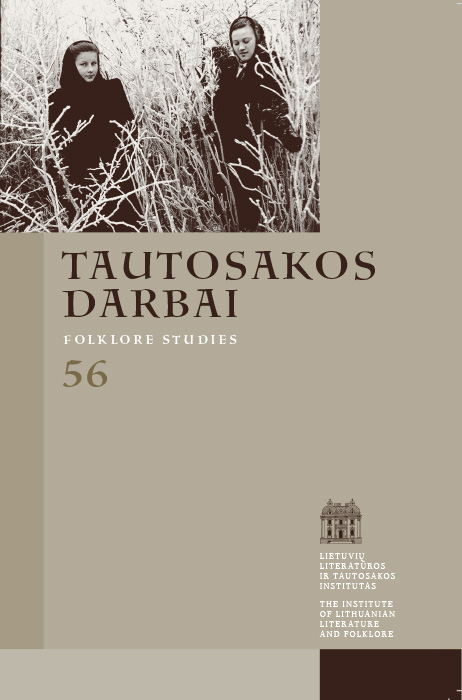Atsigręžiant į lietuvių liaudies dainų skelbimo ištakas
Santrauka
Svarstant ikirašytinės ir rašto kultūros santykių istorinę refleksiją siekiama nuodugniau aptarti rašto sąlygomis atsirandančias neįprastas dainuojamajai tautosakai, kaip procesui, būsenas. Gerai žinoma, kad rašto kultūra dažniausiai pagrįstai yra reflektuojama kaip neabejotinas kultūros pažangos rodiklis. Šio kultūrinio vyksmo palankių vertinimų akiratyje savaime atsiduria ir vėlesniais rašto istorijos tarpsniais prasidėjęs liaudies dainų užrašinėjimas bei spausdinimas. Abu fiksavimo būdai Lietuvos kultūros istorijoje yra vienalaikiai reiškiniai, tačiau jau pradiniame etape (nuo XVIII a. vid. iki XIX a. pr.) ypač išauga liaudies dainos sklaidos spausdintu žodžiu reikšmė. Straipsnyje siekiama persvarstyti, iš naujo interpretuoti, kokioje sociokultūrinėje erdvėje kristalizavosi šis naujasis liaudies kūrybos sklaidos būdas, kokius tikslus turėjo pirmieji liaudies poezijos skelbėjai ir kaip jiems pavyko juos įgyvendinti, žvelgiant iš didelio istorinio nuotolio – dabarties laiko. Dėmesys koncentruojamas iš esmės į vieną lietuvių dainų raštijos pradžios aspektą – kaip ir kodėl pasikeičia liaudies dainos būvis, jai tapus spausdintu šaltiniu. Šiai problemai gvildenti pasitelkiama analitinė hermeneutinio pobūdžio interpretacija.
Atsisiuntimai
Skaitomiausi šio autoriaus(ų) straipsniai
- Bronė Stundžienė, Iš sovietinės dainotyros: tarp pasirinkimo ir prievolės , Tautosakos darbai: T 65 (2023): Tautosakos darbai
- Bronė Stundžienė, Apdainavimų naratyvas ir jo istorinės atminties kontekstai , Tautosakos darbai: T 63 (2022)
- Živilė Ramoškaitė, Bronė Stundžienė, Apžvelgiant dainotyros horizontus. Bronę Stundžienę kalbina Živilė Ramoškaitė , Tautosakos darbai: T 64 (2022)
- Bronė Stundžienė, Kraštovaizdžio raišką dainose apmąstant , Tautosakos darbai: T 47 (2014)
- Bronė Stundžienė, Dainų pašaukti: knyga apie vieno folklorinio ansamblio gyvenimą , Tautosakos darbai: T 57 (2019)
- Bronė Stundžienė, Lietuvių talalinė: šiapus ir anapus leidžiamo juoko ribų , Tautosakos darbai: T 59 (2020)
- Bronė Stundžienė, Šeimos naratyvas dainose: ritualo atodangos ir kintančių kontekstų reikšmė , Tautosakos darbai: T 51 (2016)
- Bronė Stundžienė, Laiko žymės Dainyno skelbimo istorijoje , Tautosakos darbai: T 61 (2021)
- Bronė Stundžienė, Įvietinta folklorinė atmintis grožinėje kūryboje: pasvalietiškoji versija , Tautosakos darbai: T 49 (2015)
- Bronė Stundžienė, Rita Černiauskienė, Gimnazistiškos vieno etnologinio tyrimo patirtys iš arčiau , Tautosakos darbai: T 57 (2019)
